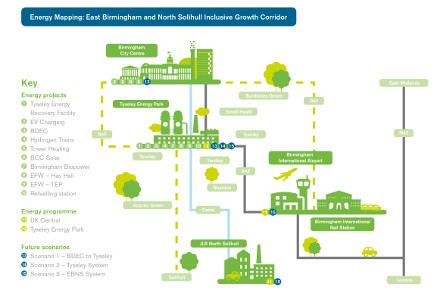
A report funded by the Climate-KIC and authored for the Birmingham Energy Institute, explores the opportunities for the development of the energy and transport infrastructure for the Eastern Birmingham corridor.
This important contribution to reshaping the development of the region contains recommendations for building on assets and infrastructure within the emerging Tyseley Innovation Zone – an area which includes the core city region and its Eastern Birmingham corridor.
The report, entitled Power to the People, was produced by the BEI as part of the Birmingham Energy Capital Climate Innovation Cluster. This is one of five city region-based climate innovation clusters spanning the UK and Europe, which brings together organisations from academia and from the public and private sectors committed to finding solutions that are positive for the climate and the economy.
Recommendations within the report are designed to establish a co-ordinated, systematic approach to climate innovation in Birmingham, addressing issues such as fuel poverty, energy security, decarbonisation and air quality.
Professor Martin Freer, head of Birmingham Energy Institute, explains: “Birmingham has one of the greatest rates of fuel poverty in the county and poor air quality across the city is causing up to 900 premature deaths a year. Clearly, a bold and co-ordinated approach to tackling these issues is required.
“Implementing the recommendations set out in this report will generate innovation and economic growth, while also reducing fuel poverty, improving air quality and creating job opportunities for local communities.”
Power to the People, produced in partnership with Birmingham City Councillor, Lisa Trickett, and Kingscote, sets out three scenarios that can build upon the established assets and planned developments of the East Birmingham and North Solihull Inclusive Growth corridor. These include:
- Harnessing the waste heat from Tyseley Energy Park to feed the Birmingham District Energy Company heat network.
- Further harness waste heat to create a localised heat network for the area, creating the potential to take many thousands of homes off gas central heating to a waste heat-fed scheme
- Drive low carbon energy development along the Eastern corridor by creating a linkage between Tyseley and Solihull, paving the way for creating an entirely self-energised region – locally generating and utilising all the heat and power required by the corridor.
In a second report also published by BEI, researchers have assessed the Climate Innovation Cluster network associated with the Connected Clusters project to review best practice on setting up these groups. Called “Connected Clusters”, this report offers a toolkit for other city regions looking to set up Climate Innovation Clusters to drive climate innovation.
Both reports have been supported by Climate-KIC, FrankfurtRheinMain Provadis School, Avaesen (Valencia), Edinburgh Centre for Carbon Innovation and the GLA in London.
The Birmingham Energy Institute is using the ideas developed in these reports to work with Birmingham City Council to further develop Tyseley Energy Park, linked it to the bold ambition of the City to reach net-zero carbon emissions by 2030.